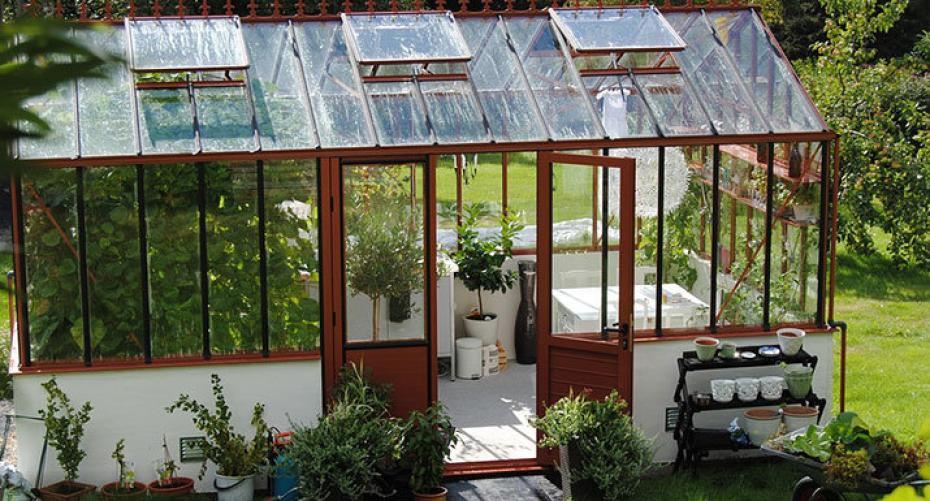Get the gardening year off to a great start by cleaning the greenhouse
Now that the Christmas and New Year festivities are over the perfect way to burn off those excess calories is to get outside and clean the green house ready for the new season’s crops. Once you have done this you are ready for the first sowing of sweet peas, cleome, broad beans, tomatoes and salad leaves. The tomatoes will need a little extra heat so you will need to invest in a small heated propagator; these can be had for as little as £12 - £14. Watch the video showing how to sow tomato seeds.
Cleaning the greenhouse is essential as seeds need as much light as possible otherwise they become spindly and weak, which makes them susceptible to infections. Any overwintering bugs and pathogens also need clearing out to prevent them from re-infecting new plants.
Pick a mild, dry, fairly calm day with just a gentle breeze; this will help dry out the greenhouse quicker.
- Remove any over-wintering plants to a sheltered position and protect with some horticultural fleece.
- Empty the green house of any staging, seed trays, tools or plant pots.
- Start at the top and sweep down any cobwebs and vegetative debris; sweep the floor. Any vegetation can go onto the compost heap; if it has fungal infections place it in the grey wheelie bin or burn.
- Scrape off any greenhouse shade paint.
- Clean and disinfect the structural parts with a non-toxic dedicated greenhouse disinfectant, Jeyes fluid or just a solution of hot soapy water. Use a soft bristled brush to enable you to get between the structure and the glass. Don’t use any harsh chemicals as any residue could prove toxic to your seedlings.
- Use the same solution to clean out the gutters. If using step ladders to clean the gutters make sure that they are on an even surface and you have on shoes with a non-slip surface. Detritus can build up in the gutters, then weeds germinate and before you know it the added weight will have brought them down. Once you have cleaned them out place a ball of crumpled chicken wire in the top of the downspout to stop any leaves from clogging your water butt and providing a medium upon which algae can grow. Don’t lean against the glass or put any weight on the gutters.
- Empty the water butt of stagnant water and scrub out with the disinfectant/soapy water solution. Use a stiff brush to scrub off the algae. Rinse out then leave to dry naturally. Once dry cover with a lid to keep out any insects or dead leaves. Infectious microbes can accumulate and algae can flourish which in turn provides a breeding ground for pests.
- Wash the glass inside and out with hot soapy water and rinse off with clean then leave to dry naturally. If you have plastic or polycarbonate glazing panels test a small piece first before using any disinfectants as they can sometimes cloud the plastic; if in doubt use hot, soapy water.
- Replace any broken panes of glass or clouded polycarbonate panels as cold draughts can be the death of tender seedlings. Don’t forget to wear gloves when handling panes of glass.
- If you have borders of soil in the greenhouse be careful what chemicals you use as they could linger in the soil and affect your plants. You can clean the greenhouse with a pressure washer but be careful that the pressure doesn’t blast out the panes of glass.
- Scrub out the trays, pots and staging before replacing. If you have wooden staging consider investing in aluminium as it is much easier to clean and doesn’t provide a breeding ground for pests and bacteria.
- Scrub the floor and make sure any uneven paving slabs are levelled; as uneven algae-covered paths can be a serious hazard.
- Once dry replace your plants.
Now relax and put your feet up with a nice cup of tea and a pile of seed catalogues.




![Kingsbury-bench-05[1].jpg](http://www.hayesgardenworld.co.uk/cdn/shop/files/Kingsbury-bench-05_5B1_5D.jpg?v=1712162737&width=1500)
![Kingsbury-bench-01[1].jpg](http://www.hayesgardenworld.co.uk/cdn/shop/files/Kingsbury-bench-01_5B1_5D.jpg?v=1712161065&width=1500)
![tw17a-4947_0[1].jpg](http://www.hayesgardenworld.co.uk/cdn/shop/files/tw17a-4947_0_5B1_5D.jpg?v=1712161495&width=1500)
![tw17a-4947_tenbury_5ft[1].jpg](http://www.hayesgardenworld.co.uk/cdn/shop/files/tw17a-4947_tenbury_5ft_5B1_5D.jpg?v=1712161172&width=1500)
![tw17a-4952_tenbury_4ft[1].jpg](http://www.hayesgardenworld.co.uk/cdn/shop/files/tw17a-4952_tenbury_4ft_5B1_5D.jpg?v=1712161034&width=1500)
![thumbnail_IMG_1565-kik_2[1].jpg](http://www.hayesgardenworld.co.uk/cdn/shop/files/thumbnail_IMG_1565-kik_2_5B1_5D.jpg?v=1712226536&width=1500)
![thumbnail_IMG_1565-kik_1[3].jpg](http://www.hayesgardenworld.co.uk/cdn/shop/files/thumbnail_IMG_1565-kik_1_5B3_5D.jpg?v=1712159637&width=1500)



![WD-XgESA[1].jpeg](http://www.hayesgardenworld.co.uk/cdn/shop/files/WD-XgESA_5B1_5D.jpg?v=1712159609&width=1500)